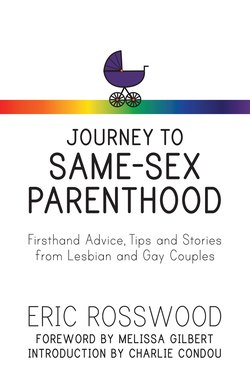Читать книгу Journey to Same-Sex Parenthood - Eric Rosswood - Страница 10
На сайте Литреса книга снята с продажи.
ОглавлениеPreface
Marriage equality has been expanding across the globe at a rapid pace and on June 26, 2015, the Supreme Court of the United States ruled that same-sex marriage was legal in all fifty states. You know what they say: First comes love, then comes marriage, then comes a baby in a baby carriage!
As lesbian, gay, bisexual and transgender relationships become more accepted, so do LGBT family units. The Williams Institute, UCLA School of Law, released research in 2013 showing that an estimated three million LGBT individuals have likely had a child and that 2 percent of Americans (roughly six million people) had an LGBT-identified parent. Now that marriage equality is legal throughout the country, these numbers will likely increase as more LGBT people come to the understanding that getting married, settling down and raising a family are obtainable goals and not just dreams.
When my husband and I decided to expand our family, we started evaluating the best way to move forward. We didn’t realize researching the topic would be so difficult and time-consuming. There were many choices for same-sex parents looking to have children; however, it was almost impossible to know about them all, let alone research them. What was an open adoption and how was it different from adoption in general? What was co-parenting? These were terms I had never heard of before.
While researching various methods and contacting different agencies, we eventually found the answers to many of our questions regarding costs, processes and legal issues. Lacking, however, were firsthand stories from people who had children themselves. What was it like for the people who went through the process?
I wanted answers to questions like: In an open adoption, how much birthparent contact is typical? If we went with surrogacy, should one of us provide the sperm so there would be a biological connection? And if we went that route, would there be feelings of guilt or resentment revolving around the fact that one of us would be genetically related to the baby and the other one wouldn’t be? If we went with foster care, what were the chances that a child would be removed from our home to go back with his or her original parents/guardians after we bonded with him or her? Would fostering be too difficult emotionally?
Sure, a few books exist out there where people have discussed their experiences, but all I could find were single books talking about one way to have a child from one person’s point of view. I wanted multiple avenues and multiple points of views in one place.
In the end, we moved forward with an open adoption. It was an amazing journey but, when reflecting back on it, I still wish we had more information going into the scenario. Because of this, I decided to create a resource for potential LGBT parents so they could learn from the experiences of others who had children through similar means. I sought out same-sex couples who had children and asked if they would share their stories on how they became parents. The number one response I got back from people was “Wow, I wish I had something like this when we were going through the process!” And so this book was born.
Journey to Same-Sex Parenthood: Firsthand Advice, Tips and Stories from Lesbian and Gay Couples is a resource filled with short stories from people in the LGBT community describing the journey of expanding their families through various means, such as adoption, fostering, surrogacy, assisted reproduction and co-parenting. It is my hope that after reading this book, you will have a better understanding of the thoughts, emotions and situations that may occur in the journey to becoming a parent and get insightful information not necessarily revealed through agencies and organizations.
This book is divided into sections to make it easy for you to quickly research and evaluate the scenarios you are most interested in. To help you in your decision, each section begins with a description of a specific family-building approach, followed by personal stories from same-sex couples who have already been through the journey.
In the appendix section, you will find important legal issues to consider and lists of questions you should ask yourself before deciding to move forward. Hopefully these questions will help you consider things you haven’t thought about beforehand and, if nothing else, if you and your partner answer them together they will help make sure you are both on the same page. There is also a list of reasons why people may choose each of the five family-building paths and the challenges they may encounter along the way.
I hope you find this resource helpful and I wish you the best in your own journey to parenthood!
